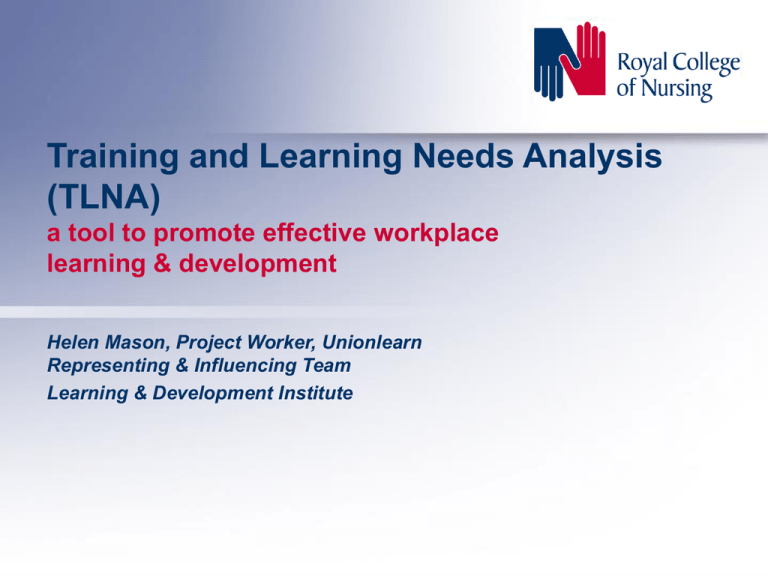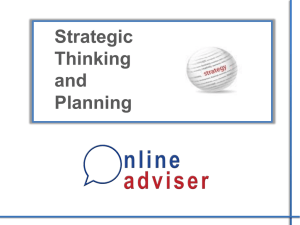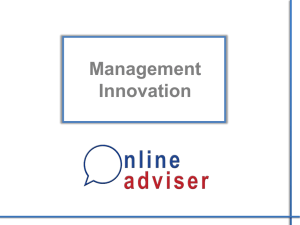Learning and Training Needs Analysis
advertisement

Training and Learning Needs Analysis (TLNA) a tool to promote effective workplace learning & development Helen Mason, Project Worker, Unionlearn Representing & Influencing Team Learning & Development Institute TLNA is … “A health check on the skills, talent & capabilities of an organisation” “The systematic gathering of data to highlight gaps in the existing skills, knowledge & behaviours of employees” The Chartered Institute of Personnel and Development (CIPD) Why is TLNA important? links training & development to the business strategy enables staff to achieve personal and career goals increases employee engagement increases productivity & retention evaluates effectiveness of training & development provision supports effective management of resources demonstrates a commitment to equality & diversity When major change – changes to services, policies, restructures, (driven internally or externally) review - part of an on -going review process (individual or team) skills gaps - when learning provision has become out of step with business strategy & current practice The best fit for your organisation’s needs Levels of TLNA Organisation as a whole What is needed to ensure employees deliver the organisations strategy Department, project, area of work New work, changing environments and organisational structures need new ways of working The individual Linking personal objectives to those of the organisation Linking together to achieve objectives Who needs to be involved? Communication HR Managers Stakeholders o Define channels of communication o Determine the audience o Communications before during and after should be carefully planned so that the findings do not come as a ‘shock’ to people Need to consult early and often Considerations for an effective TLNA relevance – how does what we are currently doing, and what we plan to do, help meet new opportunities and challenges? alignment – will it fit with the organisation’s priorities? measurement – how will you evaluate the changes (return on investment, cost, KPI’s, staff retention)? accurate & inclusive – how will you ensure data is a true reflection of the current situation? Some considerations for scoping a TLNA do you have the resources to to collect / analyse the data? make recommendations based on the data? plan and budget for the response to the LTNA? & senior level buy –in & support? Types of TLNA data to consider business objectives technology & organisation of work employee demographics education & qualifications job roles & responsibilities current competence employee status & location employee attitudes & culture documentation interviews surveys HR databases existing competence frameworks appraisal & performance management portfolios The outcomes as a strategy for change big picture – what does this research tell you & how can it inform business planning & budgeting? prioritisation – what is urgent & what will be the learning outcomes? learning interventions – what changes in learning & development opportunities will you recommend? staff engagement – how will this be communicated to staff & who will access those opportunities? evaluation – when will you evaluate your interventions & when will you review / undertake another TLNA? Some key principles an effective TLNA should include clarity of purpose credibility of evidence creative solutions clear communication clear cost/ benefit analysis The role of the LR in a TLNA undertake a local TLNA contribute to a larger TLNA encourage members to engage with TLNA support members to understand the consequences and opportunities resulting from a LTNA Representing members and ensuring learning needs are considered Negotiating learning opportunities Organising Using training and learning needs analysis (TLNA) to support members Campaigning for learning needs analysis and learning provision Influencing the learning agenda Communicating with members and the organisation about training needs TLNA & the LR role descriptors 1. 2. 3. 4. 5. 6. 7. promotes the value of learning and training in the workplace supports members in analysing their learning or training needs keeps up to date with learning opportunities contributes to the development of a learning organisation supports the development and implementation of a workplace learning strategy negotiates, and supports Continuing Professional Development in the workplace promotes access to lifelong learning 8. 9. 10. 11. 12. 13. supports local and national policies, initiatives and campaigns which promote learning supports RCN members in planning and managing their learning directs RCN members to information, resources and support systems that enable access to learning opportunities and resources, for example the RCN Learning Zone, Library and Information, R&D Coordinating Centre contributes where appropriate to the organisation of learning opportunities to meet RCN members’ learning needs provides information and advice to RCN members on learning related issues identifies appropriate information to use in matters related to member learning











